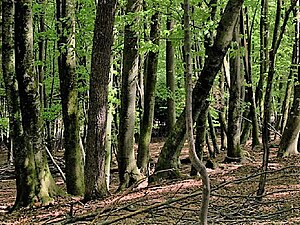
Forests, natural and artificial, provide humans and animals with shelter and food, as well as providing important environmental services such as maintaining groundwater tables, preventing erosion and fixing carbon dioxide from the air.
Wood is a basic resource for meeting human needs. It has always been important as a cooking fuel and building material. But throughout history, expanding human settlements have threatened and eventually destroyed forests. To the individual farmer, the forest is often a nuisance to be cleared away so that the land can be farmed. To the villager, the forest is the provider of plentiful cooking fuel. And to the industrialist, the forest is the source of plywood, paper, cardboard, and lumber to meet the enormous demands of industrial societies. The result has been that a potentially renewable resource has generally been exploited as a one-time boon for the first to arrive.
The consequences of unrestrained deforestation are many. The cultivation of hillsides generally leads to rapid erosion of topsoil and loss of productive potential. The removal of trees reduces the soil's ability to retain water, leading to ever-increasing cycles of flood and drought in the lands below. Inefficient cooking methods and a lack of deliberate replanting of fuelwood trees have forced millions of the poor to spend a large part of each day hunting for fuel and carrying it long distances on their backs. An unequal portion of this burden falls on women. This time-consuming, exhausting work further guarantees their poverty. In search of maximum immediate production from a piece of land, lumbering companies around the world have clear-cut the forests, leaving a devastated landscape vulnerable to erosion, and destroying any potential for sustained production.
"The humid forests of the tropics once occupied at least 1600 million hectares (4000 million acres), and have not only been the main centers for living species on earth, but have held the lands together, moderated and modified world climates, and helped to maintain a desirable balance of atmospheric gasses. Now they are vanishing at an incredible rate. There are reported to be 935 million hectares in actual humid tropical forest, a 40% reduction in total area. They are disappearing at a rate of sixteen million hectares per year...." - Ray Dasmann, "Planet Earth-1980", 1980.
Some observers are convinced that the considerable local, national and international problems associated with deforestation will be followed by global climatic shifts if deforestation is not brought under control within the next ten years. World food production is directly threatened by local soil erosion, floods and droughts, and climatic changes that mean shifting rainfall patterns and expanding deserts.
Forest Gardens[edit | edit source]
"Forest gardening is a low-maintenance organic plant-based food production and agroforestry system based on woodland ecosystems, incorporating fruit and nut trees, shrubs, herbs, vines and perennial vegetables which have yields directly useful to humans. Making use of companion planting, these can be intermixed to grow in a succession of layers, to replicate a woodland habitat." (Source: https://en.wikipedia.org/wiki/Forest_gardening) I.e. see http://www.agroforestry.co.uk/ http://blog.cifor.org/8165/diversified-forest-gardens-can-reduce-food-security-risks-in-latin-america/ http://www.motherearthnews.com/Organic-Gardening/2007-08-01/Plant-Edible-Forest-Garden-Permaculture.aspx
Info sources on forests[edit | edit source]
- Global Forests Information Service
- http://web.archive.org/web/20120405144150/http://www.metsalehti.fi:80/Page/5698fd0e-dea5-4b8b-be09-e9615bd09361.aspx Metsäkustannus is a multi-channel publishing house specialising in forestry. We are the leading provider of forestry information in Finland. Our business idea is to improve private forestry by publishing forestry information in various ways. The forestry journal called Metsälehti has been published since 1933. Its circulation is nearly 40 000 copies. The magazine format Metsälehti Makasiini was born in 1995. Metsälehti and Metsälehti Makasiini are a joint-magazine and together they are published 24 times per year. Metsälehti reaches practically all foresters and the main part of the active forest owners.
- Collaborative partnership on forests - FAO.